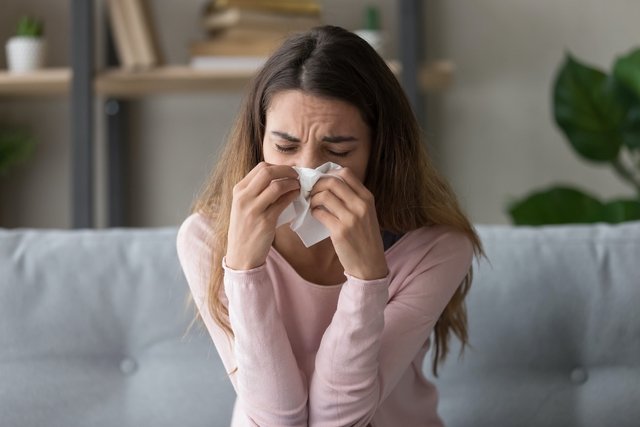Dust allergy occurs mainly because of the allergic reaction caused by dust mites, which are small animals that can accumulate in carpets, curtains and beds, leading to symptoms such as sneezing, itchy nose, dry cough, difficulty breathing and redness. in the eyes, appearing mainly after cleaning or when entering places that have been closed for a long time.
Treatment for dust allergy should be based mainly on environmental control measures, this means maintaining home hygiene, changing bedding frequently and avoiding the use of carpets and stuffed animals. If symptoms do not improve even with these measures, it is necessary to consult a general practitioner or allergist so that anti-allergy medications or corticosteroids can be prescribed.

Main symptoms
The symptoms of dust allergy are similar to those that appear in respiratory allergies, which can be:
- Constant sneezing;
- Dry cough;
- Difficulty breathing;
- Shortness of breath and noises when breathing;
- Itchy nose and eyes;
- Runny nose;
- Watery and red eyes;
- Bumps on the skin.
Symptoms generally appear when cleaning the house, after waking up, when touching stuffed animals or when entering places with carpet or that have been closed for a long time.
To confirm dust allergy, it is important to consult a general practitioner or allergist who will analyze these symptoms and may request blood tests and an allergy test, which is carried out in the doctor’s office and aims to identify the cause of the symptoms. See how the allergy test is done.
Online symptom test
To find out if you may have an allergy, such as dust allergy, please list your symptoms below:
This test is only a guidance tool and, therefore, is not intended to provide a diagnosis and does not replace consultation with an allergist, immunologist or general practitioner.
Possible causes
Dust allergy occurs due to an exaggerated reaction of the body’s defense cells in the presence of proteins released by dust mites, their excrement or fragments of their body, which are very small animals, invisible to the naked eye, that feed on the remains of dust. human skin and accumulate in warm, humid places, such as carpets, curtains, rugs, bedding, sofas and stuffed animals.
The type of mite that most causes dust allergies is of the genus Dermatophagoides, and is also the cause of diseases such as atopic dermatitis, allergic rhinitis and asthma, which is a chronic inflammation of the lung caused by allergies. Find out more about what asthma is and the main types.
What to do to improve
To improve the symptoms of dust allergy, it is essential to avoid contact with objects that may contain dust and consequently dust mites, as well as avoiding being in very closed and humid places.
If the allergy does not improve and the symptoms worsen even after reducing the person’s contact with dust, it is necessary to consult a general practitioner or allergist so that the use of anti-allergy medications, such as Desloratadine and Polaramine, or even corticosteroids, such as Prednisone. In some cases, your doctor may recommend using an allergy shot to reduce allergic attacks. Find out more about how allergy injections work.
How to prevent allergic attacks
To prevent dust allergy attacks, it is important to take environmental control measures, such as:
- Keep the house airy;
- Clean your home regularly;
- Avoid feather or cotton pillows and duvets, opting for synthetic polyester fabrics;
- Clean the floor with a damp cloth to avoid creating dust;
- Avoid carpets and curtains in the bedroom;
- Give preference to roller blinds, which are easier to clean than curtains;
- Clean the carpets with a vacuum cleaner, at least twice a week;
- Change bed linen every week, washing it in the machine with hot water;
- Avoid having stuffed animals in the bedroom;
- Wear a protective mask when cleaning very dusty places.
Furthermore, if you have pets at home, it is important to avoid their contact with the bed, so that they do not accumulate hair, which also causes allergies and is food for dust mites. See what the symptoms of allergy to animal hair are.
Bibliography
- INTERMOUNTAIN HEALTHCARE. Dust Allergy. Disponível em: <https://intermountainhealthcare.org/services/allergy-immunology/conditions/dust-allergy/>. Acesso em 11 fev 2020
- RUBINI, Norma de PM et al. Practical guide on environmental control for patients with allergic rhinitis. Arq Asthma Allerg Immunol. Vol.1, n.1. 7-22, 2017
- INFORMEDHEALTH.ORG . Dust mite allergies: Overview. 2017. Available at: <https://www.ncbi.nlm.nih.gov/books/NBK447098/>. Accessed on February 11, 2020
- WILSON, Jeffrey M.; PLATTS-MILLS, Thomas A.E. Home Environmental Interventions For House Dust Mite. J Allergy Clin Immunol Pract. Vol.6, n.1. 1-7, 2018

Sign up for our newsletter and stay up to date with exclusive news
that can transform your routine!
Warning: Undefined array key "title" in /home/storelat/public_html/wp-content/plugins/link-whisper-premium/templates/frontend/related-posts.php on line 12
Warning: Undefined array key "title_tag" in /home/storelat/public_html/wp-content/plugins/link-whisper-premium/templates/frontend/related-posts.php on line 13



